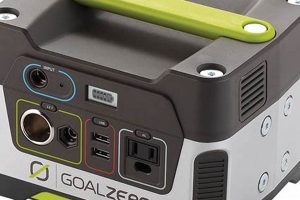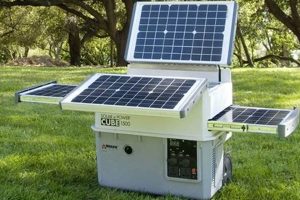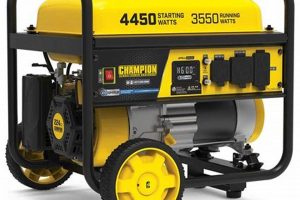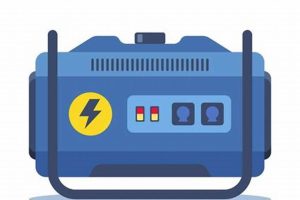A system designed for safe and convenient connection of a mobile power source to a building’s electrical system typically includes a power inlet box, a transfer switch, and the necessary wiring. This allows homeowners or businesses to quickly power essential circuits during a utility outage. For instance, a pre-wired inlet box installed near a building’s electrical panel enables easy connection to a generator through a heavy-duty power cord.
Such systems provide a crucial backup power solution during emergencies, ensuring the continued operation of critical appliances like refrigerators, sump pumps, and heating systems. This capability minimizes disruption and potential damage caused by power outages, offering peace of mind and enhanced safety. Historically, connecting a generator directly to household appliances posed significant safety risks. Modern systems address these concerns with integrated safety features like interlocks that prevent simultaneous connection to both utility power and the generator, mitigating the risk of backfeeding and electrocution hazards for utility workers.
The following sections will delve into the specifics of selecting, installing, and maintaining these valuable power solutions. Topics covered will include various system types, sizing considerations, safety procedures, and recommended maintenance practices.
Tips for Backup Power System Implementation
Proper planning and execution are crucial for a safe and effective backup power solution. These tips provide guidance for successful implementation.
Tip 1: Accurate Load Calculation: Determine the wattage requirements of essential appliances and equipment. This informs the necessary generator capacity and prevents overloading.
Tip 2: Professional Installation: Engaging a qualified electrician ensures adherence to safety codes and proper system integration, minimizing risks.
Tip 3: Proper Inlet Box Placement: Locate the inlet box in a readily accessible and weather-protected area, facilitating convenient generator connection.
Tip 4: Transfer Switch Selection: Choose a transfer switch that matches the generator’s capacity and the number of circuits requiring backup power. Consider automatic transfer switches for seamless transition during outages.
Tip 5: Regular System Testing: Periodically test the entire system, including the generator and transfer switch, to verify functionality and identify potential issues.
Tip 6: Adherence to Safety Procedures: Always disconnect the main utility breaker before operating the generator to prevent backfeeding. Consult the owner’s manuals for specific safety guidelines.
Tip 7: Preventative Maintenance: Regular generator maintenance, including oil changes and air filter replacements, ensures reliable operation during emergencies.
Implementing these recommendations ensures a reliable and safe backup power system, mitigating the impact of power outages and protecting critical equipment.
By understanding and applying these principles, homeowners and businesses can significantly enhance their preparedness for unforeseen power disruptions.
1. Safety
Safe operation of a portable generator and transfer kit is paramount. Improper use can lead to serious hazards, including electrocution, fire, and carbon monoxide poisoning. Understanding and implementing safety procedures is crucial for protecting life and property.
- Preventing Carbon Monoxide Poisoning
Generators produce carbon monoxide, an odorless, colorless, and deadly gas. Never operate a generator indoors, including garages, basements, or crawl spaces. Ensure adequate ventilation around the generator, locating it far from open windows, doors, and vents. Installing carbon monoxide detectors provides an additional layer of protection.
- Electrocution Hazards
Improper connection of a generator to a home’s electrical system can lead to backfeeding, energizing downed power lines and posing a lethal threat to utility workers. Always use a properly installed transfer switch to isolate the generator power from utility power. Never connect a generator directly to a wall outlet.
- Fire Prevention
Generators become hot during operation. Maintain adequate clearance around the generator to prevent flammable materials from igniting. Allow the generator to cool completely before refueling. Store fuel in approved containers away from heat sources.
- Safe Refueling Procedures
Turn off the generator and allow it to cool down completely before refueling. Gasoline spilled onto a hot engine can ignite. Refuel outdoors in a well-ventilated area, away from open flames and sparks.
Adhering to these safety protocols is essential for the safe and effective use of a portable generator transfer kit. Neglecting these precautions can have dire consequences. Consulting the manufacturer’s instructions and seeking professional guidance enhances safety and ensures proper operation.
2. Power Inlet Box
The power inlet box serves as the critical link between a portable generator and a building’s electrical system within a transfer kit. This weatherproof-enclosed receptacle provides a safe and standardized connection point for the generator’s power cord. Its presence eliminates the need for risky and potentially damaging direct connections to household circuits, streamlining generator hookup and enhancing safety. Consider a homeowner needing to power essential circuits during a hurricane. A properly installed inlet box, often located near the main electrical panel, allows quick connection of the generator via a heavy-duty power cord, enabling swift power restoration to critical systems.
The inlet box’s role within the transfer kit is integral to the system’s functionality. It acts as the entry point for generator power, which is then routed through the transfer switch to designated circuits. This setup isolates the generator power from the utility grid, preventing backfeeding a dangerous phenomenon that can energize downed power lines and endanger utility workers. Furthermore, the standardized design of inlet boxes ensures compatibility with a wide range of generator models and power cords, simplifying the connection process and reducing the risk of improper hookups. Without a properly installed and rated inlet box, the safety and efficacy of the entire transfer kit are compromised.
Proper selection and installation of the power inlet box are critical for safe and reliable generator operation. Factors like amperage rating and NEMA configuration must align with both the generator’s output and the transfer switch specifications. Professional installation ensures secure connections, proper grounding, and adherence to electrical codes. This attention to detail minimizes risks associated with electrical faults and safeguards both the generator and the building’s electrical system. Understanding the function and importance of the power inlet box within a portable generator transfer kit is fundamental for anyone seeking a robust and secure backup power solution.
3. Transfer Switch
The transfer switch forms the heart of a portable generator transfer kit, serving as the crucial safety and control mechanism. It allows homeowners to safely connect a portable generator to a building’s electrical system, isolating the generator power from the utility grid. This isolation prevents dangerous backfeeding, which can energize downed power lines and pose a lethal threat to utility workers. A transfer switch also enables selective powering of essential circuits, preventing generator overload. Consider a scenario where a homeowner needs to power critical appliances like a refrigerator, furnace, and a few lights during a power outage. The transfer switch allows these specific circuits to draw power from the generator while remaining disconnected from the utility grid.
Transfer switches are categorized into manual and automatic types. Manual transfer switches require the user to physically flip a switch to change the power source, offering a cost-effective solution for smaller applications. Automatic transfer switches, while more expensive, automatically detect a power outage and transfer the load to the generator, providing a seamless transition without user intervention. This automatic functionality is particularly beneficial for critical systems requiring uninterrupted power, such as medical equipment or security systems. Choosing the correct transfer switch depends on individual needs and budget. Sizing is crucial; the transfer switch must be rated to handle the generator’s maximum power output. Incorrectly sized switches can lead to system failure or even fire hazards.
Understanding the function and importance of the transfer switch within a portable generator transfer kit is essential for safe and effective backup power implementation. This component ensures the safety of both the user and utility personnel while enabling efficient power distribution during outages. Professional installation is strongly recommended to ensure correct wiring, adherence to electrical codes, and overall system reliability. Selecting the appropriate transfer switch type and size is critical for optimizing performance and preventing potential hazards. This careful consideration, combined with regular system testing and maintenance, contributes significantly to a reliable and robust backup power solution.
4. Wiring and Cords
Appropriate wiring and cords are fundamental components of a safe and functional portable generator transfer kit. These elements facilitate the secure transmission of power from the generator to the transfer switch and subsequently to the designated circuits. Selecting and installing the correct wiring and cords is crucial for preventing overheating, minimizing power loss, and ensuring overall system reliability. Ignoring these considerations can lead to significant safety hazards and compromise the efficacy of the backup power solution.
- Conductor Gauge and Ampacity
Conductor gauge refers to the thickness of the wire. A lower gauge number indicates a thicker wire capable of carrying more current. The selected wire gauge must match the amperage requirements of the generator and the connected circuits. Using undersized wiring can lead to overheating, insulation melting, and potential fire hazards. For instance, a generator supplying 30 amps requires a wire gauge rated for at least 30 amps, potentially requiring a 10-gauge wire depending on the length of the run. Consulting an electrician ensures proper wire sizing based on the specific application.
- Cord Length and Voltage Drop
Longer cords introduce voltage drop, reducing the effective power delivered to appliances. Excessive voltage drop can damage sensitive electronics and impact the performance of motors. Selecting appropriately sized cords and minimizing their length helps mitigate voltage drop. For example, using a 100-foot extension cord with a small gauge for a high-power appliance can result in significant voltage drop, potentially causing malfunction or damage. Shorter, heavier-gauge cords are preferable for minimizing voltage drop and ensuring optimal appliance performance.
- Connector Types and Compatibility
Correct connector types are essential for secure connections and preventing compatibility issues. The connectors on the generator, power inlet box, and transfer switch must match. Using incompatible connectors can lead to loose connections, overheating, and potential arcing. For instance, a generator with a L14-30R receptacle requires a cord with a matching L14-30P plug. Mismatched connectors not only prevent proper power transmission but also present safety hazards.
- Outdoor Rated Cords and Weather Protection
Given the outdoor use of portable generators, employing outdoor-rated cords is imperative. These cords feature durable insulation resistant to weather, abrasion, and sunlight. Protecting connections from moisture is critical. Using indoor-rated cords outdoors can lead to insulation degradation, short circuits, and shock hazards. Properly rated and protected connections ensure the safe and reliable operation of the transfer kit in various weather conditions.
The proper selection and installation of wiring and cords within a portable generator transfer kit are paramount for safe and effective operation. Considering factors like conductor gauge, cord length, connector compatibility, and weather resistance ensures efficient power delivery and mitigates potential hazards. Professional consultation is highly recommended for determining the appropriate specifications for specific applications and ensuring adherence to safety standards. These careful considerations contribute significantly to a robust and reliable backup power system.
5. Installation
Proper installation is paramount for the safe and effective operation of a portable generator transfer kit. Incorrect installation can lead to serious hazards, including fire, electrocution, and damage to appliances. Adhering to manufacturer instructions and local electrical codes is crucial. Professional installation by a qualified electrician is strongly recommended to ensure compliance with safety standards and optimal system performance. This guarantees the system’s reliability during power outages and safeguards both the building and its occupants.
- Site Selection and Inlet Box Placement
Choosing the correct location for the generator and the power inlet box is crucial for safe and convenient operation. The generator should be placed outdoors in a well-ventilated area, away from windows, doors, and vents to prevent carbon monoxide buildup. The inlet box, which connects the generator to the transfer switch, should be located in a readily accessible and weather-protected area, typically near the main electrical panel. Proper placement simplifies generator connection and ensures protection from the elements. For instance, placing the inlet box near the electrical panel minimizes wiring runs and facilitates a more efficient installation. Conversely, installing the generator too close to the building poses fire and carbon monoxide poisoning risks.
- Transfer Switch Wiring and Connection
Correct wiring of the transfer switch is critical for safe and reliable operation. The transfer switch must be properly connected to the generator inlet box, the main electrical panel, and the selected branch circuits. Incorrect wiring can lead to backfeeding, energizing downed power lines and endangering utility workers. Furthermore, improper connections can overload circuits, damage appliances, and create fire hazards. For example, miswiring the neutral conductor can create dangerous voltage imbalances. Professional installation ensures correct wiring configurations and compliance with electrical codes, mitigating these risks.
- Grounding and Bonding
Proper grounding and bonding are essential for electrical safety. Grounding provides a low-resistance path for fault currents to flow, preventing electrical shock. Bonding connects all metallic non-current-carrying components, equalizing potential and further minimizing shock hazards. Inadequate grounding or bonding can result in dangerous voltage gradients, increasing the risk of electrocution. For instance, failing to properly ground the generator frame can create a shock hazard during operation. Meticulous attention to grounding and bonding details during installation is critical for overall system safety.
- Testing and Inspection
Thorough testing and inspection after installation are crucial for verifying proper system functionality. Testing the transfer switch operation ensures correct power transfer between the utility and the generator. Inspecting all connections for tightness and proper insulation verifies the integrity of the installation. Testing also helps identify potential issues early on, preventing future problems. For example, a test run can reveal incorrect wiring configurations or inadequate grounding, allowing for prompt corrective action. A comprehensive inspection and testing procedure are essential for ensuring the reliability and safety of the installed system.
The correct installation of a portable generator transfer kit is a multifaceted process crucial for safe and reliable operation. Addressing each aspectsite selection, transfer switch wiring, grounding, and testingcontributes to a robust and effective backup power solution. Professional installation ensures adherence to safety standards, minimizes risks, and provides peace of mind during power outages. A properly installed system offers a reliable source of backup power, protecting critical appliances and ensuring the safety of building occupants.
Frequently Asked Questions
This section addresses common inquiries regarding portable generator transfer kits, providing concise and informative responses to facilitate informed decision-making.
Question 1: What is the primary function of a transfer switch within a portable generator transfer kit?
A transfer switch safely connects a portable generator to a building’s electrical system, isolating the generator power from the utility grid. This prevents backfeeding, a dangerous phenomenon that can energize downed power lines, posing a risk to utility workers. It also allows selected circuits to be powered by the generator during an outage.
Question 2: Is professional installation necessary for a portable generator transfer kit?
Professional installation by a qualified electrician is strongly recommended. This ensures adherence to local electrical codes, proper grounding, and safe integration with the building’s electrical system, mitigating potential hazards and ensuring optimal system performance. Incorrect installation can lead to serious safety risks.
Question 3: How is the appropriate generator size determined for a specific application?
Generator size is determined by calculating the total wattage of the appliances and equipment intended to be powered during an outage. Consider both starting wattage (required for motor start-up) and running wattage (required for continuous operation). Overloading a generator can damage both the generator and connected appliances.
Question 4: What are the key safety considerations when operating a portable generator?
Operate generators outdoors in well-ventilated areas to prevent carbon monoxide poisoning. Never refuel a hot generator. Ensure proper grounding to prevent electrocution. Use a transfer switch to prevent backfeeding. Consult the manufacturer’s instructions for detailed safety procedures.
Question 5: What maintenance is required for a portable generator transfer kit?
Regular generator maintenance, including oil changes, air filter replacements, and spark plug inspections, is essential for reliable operation. Periodically test the entire system, including the transfer switch, to ensure proper functionality. Consult the manufacturer’s recommendations for specific maintenance intervals.
Question 6: What are the different types of transfer switches available, and how do they differ?
Manual transfer switches require the user to physically change the power source, while automatic transfer switches detect outages and transfer the load to the generator automatically. Automatic switches offer greater convenience but are typically more expensive. Selection depends on individual needs and budget.
Understanding these key aspects of portable generator transfer kits is crucial for making informed decisions and ensuring safe and effective backup power implementation. Consulting with qualified professionals can provide further guidance tailored to specific circumstances.
The following section will discuss the advantages and disadvantages of various generator fuel types, including gasoline, propane, and diesel.
Portable Generator Transfer Kit
Portable generator transfer kits represent a crucial investment for ensuring power reliability during outages. This exploration has highlighted the essential components, including the power inlet box, transfer switch, appropriate wiring, and critical safety considerations. Careful consideration of generator sizing, transfer switch type (manual or automatic), and professional installation practices are paramount for effective implementation. Safe operation requires strict adherence to established procedures, preventing hazards like carbon monoxide poisoning, electrocution, and fire. Regular maintenance, including system testing and generator upkeep, is vital for ensuring long-term reliability and performance.
Reliable backup power is no longer a luxury but a necessity in an increasingly unpredictable world. Investing in a properly sized and professionally installed portable generator transfer kit provides peace of mind, safeguards critical systems, and mitigates the disruptive impact of power outages. Thorough planning and a commitment to safety protocols are essential for maximizing the benefits of this valuable technology and ensuring preparedness for unforeseen power disruptions.






